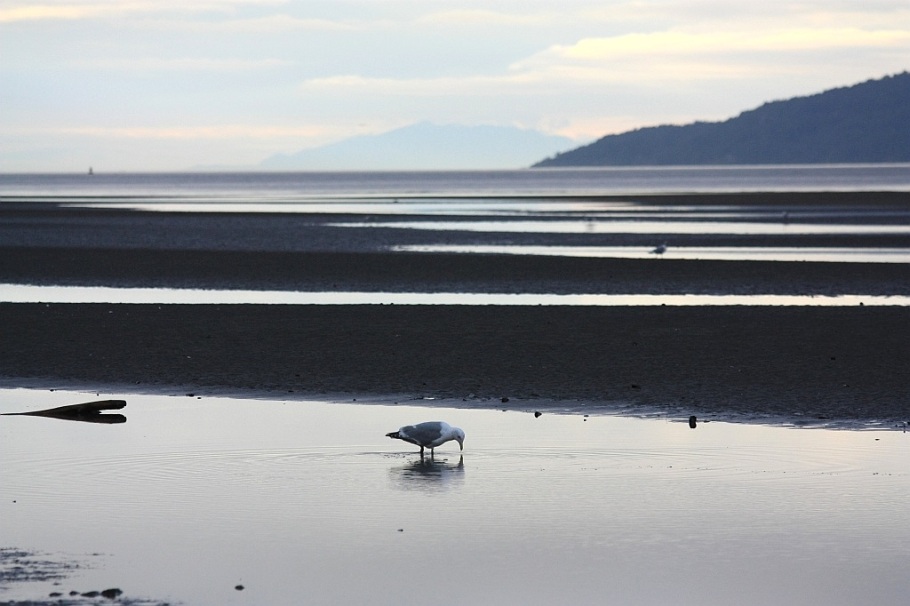My Vancouver: western beaches in winter (2012)
It’s easy to forget Vancouver has a number of beaches on both sides of Burrard Inlet. Returning to my hometown to begin my year-long around-the-world (RTW) trip was a good opportunity to revisit a number of places I hadn’t seen or visited in decades. One area was the “western beaches”; namely, Jericho Beach, Locarno Beach, and Spanish Banks along the northwest shoreline of the city.
Seasons & History
While the summer is an obvious time to visit, I chose the winter (February), because I believe the beaches are beautiful at any time of year. With a light sweater or fleece and a waterproof windbreaker jacket on top, anyone is more than ready to head out to the beach for a walk, a bicycle ride, or even, wander out into the waters of the Salish Sea for sailing, kayaking, or paddleboarding.
For its flat terrain and easy beach access, Jericho Beach was once the site of a First Nations village, before the land was taken over for use as a military base and, subsequently, a logging camp in the last-half of the 19th-century. In reference to Jeremiah (Jerry) Rogers’ logging operation in the area, “Jerry’s Cove” was likely corrupted over time to become “Jericho”.
To the west of Jericho Beach is Locarno Beach, which is more of a “quiet” area. By comparison with adjacent beaches, Locarno Beach is smaller, feels more intimate, and frequented by locals, couples, and young families. The City of Vancouver notes:
Before the European settlers arrived, this site was home to a First Nations Village called Eyalmu, roughly translating to “good camping ground.” Spanish explorer Narvaez noted it in his journals in 1791. It was named in 1925 by the Municipality of Point Grey after having been purchased from the Provincial Government (of British Columbia). The name comes from the Locarno Pact, an agreement which outlawed war signed in Locarno, Switzerland in 1925.
Farther west is a broad expanse of beachland called the Spanish Banks, known to the local First Nations as “Pookcha”, or “the back of the whale rising and falling.” The area is given the “Spanish” name for the meeting in 1792 between English Captain George Vancouver and Spanish Captains Cayetano Valdés y Flores and Dionisio Alcalá Galiano; this event has also given the name, English Bay, to the nearby body of water where the meeting took place. At low tide, the waters of English Bay recede to about one kilometre from shore. As a result, Spanish Banks expands to become a very large muddy tidal flat on which to walk and explore – with a good set of waterproof boots, of course. And in the distance the steel and cement fingers of the city’s downtown skyline lingers in the background, beckoning you forward to whatever temptations lie therein.

Hobbyists at Royal Vancouver Yacht Club

Showers for a different season, Jericho Beach

Royal Vancouver Yacht Club

Corner hut

Georgia Strait, Howe Sound, and all dem Coastal Mountains

A sitting log, waiting for the summer: Jericho Beach

Jericho Beach

Pickup

Two ways of “a day out sailing”

Duet, Jericho Beach

Trio

“UBC 25”

Paddle boarding, a rental

Locarno Beach in February

BC Ferries between mainland (Horseshoe Bay) and Vancouver Island (Departure Bay)

Heading out to open water

A day out, in mid-February

A family arrangement, Locarno Beach

Low tide: Spanish Banks

Reflective strips, Spanish Banks

Feeding at low tide, Spanish Banks

Receded shoreline at Spanish Banks

Could someone walk directly to the CBD?

Wading out at low tide, Spanish Banks

Solitary contemplation, Spanish Banks

Across English Bay to West End skyline, Spanish Banks
These beaches can be reached by car or by public transit on Translink routes 4, 44, 84, or C19.
I made these photos on 11 February 2012; low tide was measured at 3pm local time with a height at 1.9 metres. This post appears on Fotoeins Fotografie at fotoeins.com as http://wp.me/p1BIdT-1Kb.

5 Responses to “My Vancouver: western beaches in winter (2012)”
You love Vancouver, don’t you! Great eye for motives, too. You make me want to go back to beautiful Vancouver. Haven’t been to most of the beaches. Only been to Kitsilano and English Bay!!
LikeLiked by 1 person
Hi, Christina! Believe it or not, I had folks like you in mind when I wrote this post. 😉 Many visitors will certainly visit the beaches at Stanley Park, Kits, and English Bay, but perhaps not the three “western” beaches or even Ambleside in West Vancouver. If the photos provide additional motivation to visit, then surely, that’s thanks enough, oder? Well, okay, a drink or two the next time we meet would be good, too. 🙂 Thanks for reading and for your comment!
LikeLike
Gotta hit them on my next visit! 😀
LikeLiked by 1 person
Yes, do! They’re worth visiting at any time of the year, except perhaps when it rains. As you saw in the post, winter is fine, too, but dressing appropriately with interior fleece and exterior windbreaker would be good. 🙂 Thanks for your comment, Jen!
LikeLike
[…] Even under grey skies, there’s something inherently beautiful about a beach on a winter day with the water and mountains in sight. At low tide, the receding waters reveal mud flats onto which one can walk out for a good kilometre or two. I wrote about my walk through Vancouver’s western beaches including Spanish Banks on my blog. […]
LikeLike